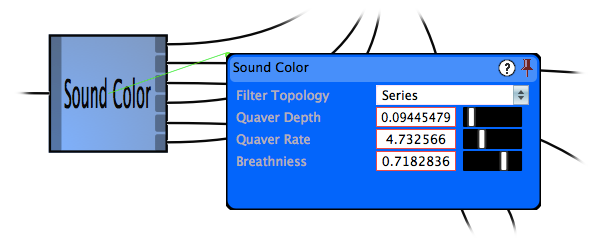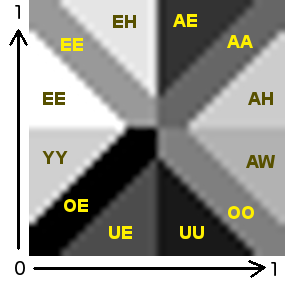
Trilobite
1.3
User Guide
|
|
Trilobite
1.3 |
|
|
|
|
|

Based largely on the work and advice of Professor Wayne Slawson (See his book, Sound Color), this module is a human vocal formant sound coloration filter with optional vocal tone generator. It can be used to add “vocal tone quality” to input signals of your own design, or as a basic “robot voice” sound source. The filter portion of this module simulates the human vocal tract using four band-pass filters, in either series or parallel routing configuration, with center frequencies tuned to produce vowel formants from spoken English as specified in Color-Class and Pitch-Class Isomorphisms: Composition and Phenomenology, by Slawson, Perspectives of New Music 43:1 (Winter 2005). The driver function, or synthesized glottal pulse, tone generation portion of this module is only activated and used when no external input signal has been routed through the module.
Input ports 1 and 2 allow x-y addressing into a radial map of vowel modes roughly arranged into a Color-Class Circle as described in Slawson's book:

This
arrangement is intended to enable close to arbitrary travel between
vowels, and would be ideal for mapping to an X-Y physical parameter
control.
The boundaries between vowels in the map above are very sharp, but the actual transition time between vowels when a boundary is crossed will be more or less gradual based on the articulation of the module, which is controlled parametrically by input to port 3. Manipulation of the articulation value is a means of controlling the naturalness of vocalizations.
The clarity of vowel sounds may be adjusted by allowing formant center frequencies to slip closer together, such that different vowel sounds are less distinguishable from each other (some people speak this way, especially when tired or after consuming alcohol). This is also known as reduction of vowels, and may be parametrically controlled by input to port 4.
The bandpass center frequencies of the individual formant filters are not absolutely fixed, but rather remain in proportional relation to each other when they slide up and down the frequency scale using using input port 5 as a formant shift scalar. This parameter, along with the frequency of the input Glottal Source, can be used to manipulate the age and gender suggested by the module's output.
For a key to understanding the tables on this page, see the Module Types page.
|
|
The Sound Color Module is available in Pro Version only. |
Adding input ports is not enabled for this module.
|
# |
Title |
Type |
Description |
|
0 |
Filter Topology |
Multiple Choice |
Has the options:
|
|
1 |
Quaver Depth |
Floating-point |
Adjusts the frequency modulation depth of formant center frequency vibrato, as an alternative to vibrato in the glottal driver function. Works both with and without external glottal driver function. Range: [0.0, 1.0], LINEAR |
|
2 |
Quaver Rate |
Floating-point |
Rate of formant center frequency vibrato in Hertz. Range: [0.0, 16.0], LINEAR |
|
3 |
Breathiness |
Floating-point |
Controls the amount of pulse-modulated white noise present in the synthesized driver function, meant to superficially imitate airflow through the glottis. Only used when input port zero is not routed. Range: [0.0, 1.0], LINEAR |
|
# |
Title |
Description |
Input Scalar Used |
Parameter Scalar Used |
|
0 |
Glottal Source |
External glottal driver function signal |
NO |
NO |
|
1 |
Formant Map X |
Sets the X (horizontal) coordinate of vowel sound to be used for filtering, as shown in the diagram above. Clamped to range [0.0, 1.0]. |
NO |
YES |
|
2 |
Formant Map Y |
Sets the Y (horizontal) coordinate of vowel sound to be used for filtering, as shown in the diagram above. Clamped to range [0.0, 1.0]. |
NO |
YES |
|
3 |
Articulation |
Sets the rate of change between changing vowel sounds. See descriptive text above for more information. The larger the input value, the more rapid the change between vocal sounds. In most cases, a value of approximately 0.2 will give the most 'human' results. Clamped to range [0.0, 1.0]. |
NO |
YES |
|
4 |
Reduction |
Sets the 'vagueness' of vowel sounds. This value is inversely proportional to the clarity of vowel sounds. See descriptive text above for more information. Clamped to range [0.0, 1.0]. |
NO |
YES |
|
5 |
Formant Shift |
The shifted offset of formant center frequencies. See descriptive text above for more information. Clamped to range [0.0, 4.0]. |
YES |
YES |
|
# |
Title |
Description |
|
0 |
Vocalized Signal |
Either a sythesized vocal sound or filtered version of Glottal Source signal.
|